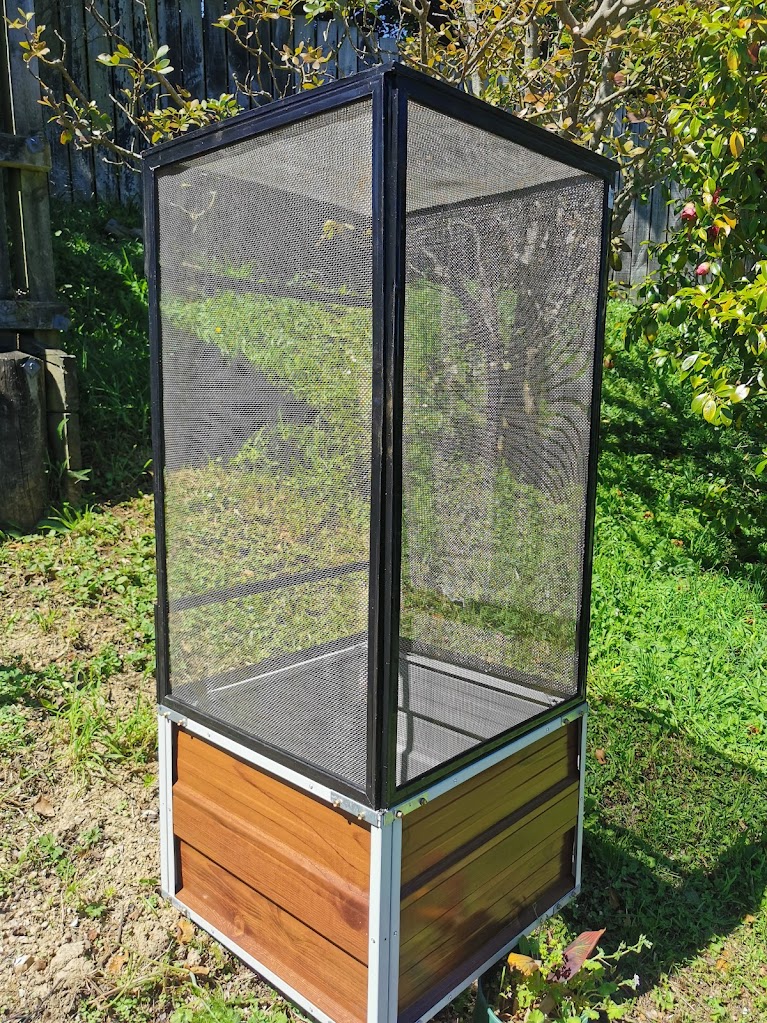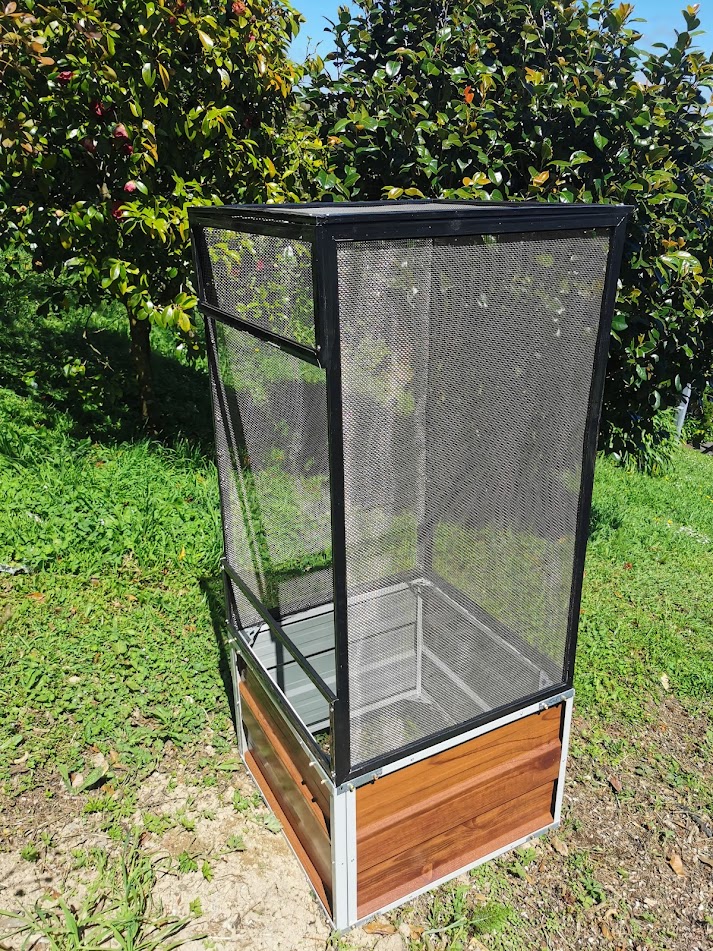Enclosure design / construction
Enclosures for NZ lizards have several basic requirements, they must be:
- Escape proof (to prevent captive lizards escaping into the wild).
- Pest-proof (to prevent predators such as rats, mice, cats or birds from entering the enclosure or injuring the lizards in your care).
- Durable, to last in variable outdoor conditions.
- Have a high quality mesh (which retains lizards and their prey items, but allows sufficient levels of UV to pass through to keep the lizards healthy and reduce the risk of metabolic bone disease).
- Allow sufficient thermal and humidity gradients for lizards to thermoregulate and find conditions that suit them (this comprises several aspects of enclosure placement and having at least three sides and the top with mesh so natural variation in temperature and humidity can occur).
- Be fully furnished with ground cover and canopy foliage to maximise use of the cage space, 2-3 retreats and basking areas per lizard.
Design:
With enclosures for New Zealand Lizards it is best to keep the design simple. A well-constructed frame with mesh on the top and at least three sides, and including an access door that is appropriately large to place items such as plants, branches, rocks, and other enclosure items inside should be sufficient.
In order to minimise the risk of escapees, some holders of New Zealand lizards utilise smaller feeding doors in addition to larger doors which are used for general enclosure maintenance. It is also advisable to include a lip of at least 10-15cm below any door / entrance to the enclosure if fast-moving terrestrial species such as Woodworthia, Dactylocnemis and Hoplodactylus geckos, or any species of skink are to be housed.
An alternative design for fast moving skinks is to construct a pen with a high-quality mesh top opening door, and smooth plastic sides (which the skinks cannot climb). However, the same enclosure design would not work for geckos, which have foot morphology allowing them to climb smooth surfaces.
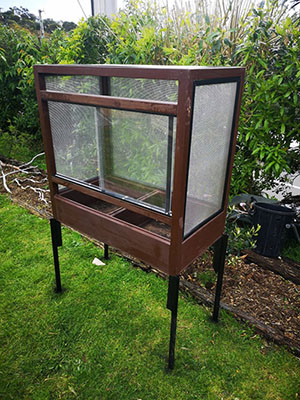
Steel Mesh and Retianing Timber Substrate Planter Base |
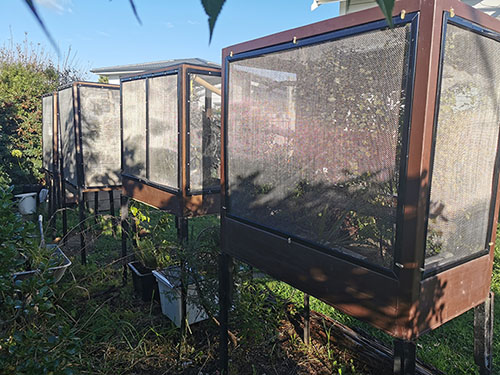
sides allow for ample UV light availibility to the lizards |
|
|
Front access door, with glass top and bottom |
Mesh:
This is one of the most-important aspects of enclosure construction, so ensure you use the best-quality mesh you can find and afford. The suitability of mesh is assessed against three criteria: how well it provides protection from predators; whether it will retain lizards (including neonate / baby lizards) and food items; and transmission of UV (sunlight). To optimise all aspects, stainless steel mesh is undoubtedly the most suitable material on the market.
The mesh-size most widely used / recommended according to current best-practice is size 8 stainless steel woven mesh, this size will retain baby lizards and most insects used for feeding native lizards (except for house flies). Mesh of this size is sold by several suppliers, including: Xcluder, Juspec, and Steel and Tube.
The transmission of sunlight, and in particular UVB is crucial for a lizard's metabolic processes and overall health. Failing to provide your animals with sufficient UVB can lead to multiple health issues including metabolic bone disease. The key feature to optimise when choosing a mesh is the open area %, this will indicate how much sunlight passes through the mesh and is accessible to lizards within the enclosure. This is calculated by a combination of the mesh 'hole size' (aperture) and wire thickness (diameter). Not all mesh of a given weave (e.g. size 8 - meaning 8 holes per inch) will be made using the same wire diameter, so to compare products and see which one will give you the best UV transmission there are several online calculators which are freely available.
Some keepers have painted their mesh black to improve visibility. However, this has proven to reduce the levels of UVB inside the enclosure so should ideally only be done on the shaded side.
A UV meter is available for hire to members of the New Zealand Herpetological Society.
Setting-up / Furnishing the enclosure
Setting up and furnishing the enclosure is probably the most complex task when keeping NZ lizards. It's easy to create an enclosure that looks appealing to humans, but requires more consideration to set up in a manner that provides your lizards with everything they need to keep them healthy. Enclosures - because of their limited size - can never give these animals access to the full range of conditions they might experience in the wild. It is therefore crucial that keepers put a good deal of thought into creating habitats/conditions within the enclosure that give the lizards as much choice as possible, and allow them to thrive, not just survive in captivity. When the lizards have everything available to them within the enclosure that they require, they will choose for themselves where they need to be. The key message is to "take care of the lizard's environment and they will take care of themselves."
Enclosure placement:
Enclosures should be sited to optimise the amount of sunlight that your lizards are getting. Enclosures housing NZ lizards should be placed in an area which receives full sun for several hours a day. They should also be sited in an aspect where the main mesh-side of the enclosure is facing the sun (i.e. North - the direction which most sunlight will be coming from in the southern hemisphere).
If perspex or glass are used on one side of the enclosure this side should be on the shaded side (facing south / away from the sun). These materials filter out all (or virtually all) of the UVB lizards require from sunlight, and lizards basking behind perspex or glass have been known to develop metabolic bone disease.
Furnishing the enclosure:
When setting up an enclosure, think about what the species you're intending to keep requires, their ecology, and how they use the environment around them (for further information about the ecology of NZ lizards refer to our section on Herpetofauna).
In general lizards must have the following:
- Basking sites (2-3 per lizard, to avoid competition / displacement).
- Areas of shade.
- Refuges / hiding places (2-3 per lizard, to avoid competition / displacement).
- Areas to slough their skin.
- Sufficient climatic variation for them to properly thermoregulate and choose where they need to be.
Always consider the natural behaviours of the lizards in your care. Many of the commonly held species, such as Mokopirirakau (forest geckos) and Naultinus (green geckos) are naturally solitary, and living with permanent ‘cage mates’ of the same species can cause long term stress.
Basking sites are crucial for all New Zealand lizards including nocturnal species which will often cryptically sun-bask throughout the day. The intensity of UV is at it's highest against the mesh and decreases with increasing distance from the mesh within the enclosure. With this in mind, it is best to place basking sites as close to the mesh as possible to increase the levels of UVB your lizards are exposed to. For arboreal species, it is best to include plants with foliage reaching the roof of the enclosure, additionally placing branches for basking along the sides and under the top-mesh of the enclosure, as close to the mesh as possible which still allows the lizards to sit on top of them. For terrestrial species this might involve placing rocks and/or logs near the side of the enclosure which gets the most sun. Some species such as Duvaucel's geckos (Hoplodactylus duvaucelii), Pacific geckos (Dactylocnemis pacificus) and geckos in the genus Woodworthia, will only bask cryptically (exposing only part of the body) near a retreat/refuge site, so it is best to place their refuge sites in locations where they can bask at the entrance.
New Zealand lizards are at risk of heat stress and can quickly die if exposed to extreme summer conditions. It is therefore crucial to provide plenty of shaded spots within your enclosure which your lizard(s) can retreat to if conditions get too hot. Shade can be provided by plants, piled up woody debris, or a piece of wood (or reflective white plastic) can be placed over part of the top of the enclosure to provide shade from the sun during summer.
Refuges are a critical and an often over-looked aspect of husbandry for new holders of NZ lizards. The type of refuges that will be used depends on the species and their ecology. For example, green geckos (Naultinus spp.) and forest geckos (Mokopirirakau spp.) will take refuge in dense foliage and tree hollows, whereas geckos from the genus Woodworthia and the majority of skinks will prefer ground based refuges such as rock piles, or logs / bark to live under. Suggested refuge sites which have been used by NZHS keepers include:
- Hollow bamboo or polythene pipe - these provide the best cover when blocked off at one end, and may be suspended above-ground for arboreal (tree-dwelling) species, or at ground level for terrestrial and fossorial species.
- Live vegetation that provide dense foliage for lizards to move through. Some ‘cage hardy’ plant examples include:
- Coprosma species - e.g. C. propinqua, C. repens, C. acerosa,
- Corokia.
- Climbing junipers.
- Grasses- e.g Carex, Lomandra.
- Astelia species.
- Spanish moss (Tillandsia usneoides) - in thick clumps, Spanish moss acts as a proxy for the dense foliage that species such as green geckos and some forest geckos take refuge in. If this is to be used as a refuge, the plant must be sufficiently thick/dense that lizards can climb inside and be protected from the sun, wind and rain.
- Stacks of bark / timber - Large pieces of bark ripped off trees and stacked 3+ layers high will provide warm, dry gaps in between where lizards will take refuge.
- Stacks of Onduline - As above, but include spacers to create gaps between the layers so that the lizards you are keeping can squeeze in. Onduline has a benefit over bark in that it will last much longer before needing to be replaced.
- Pieces of broken terracotta pot - can be placed on top of well-draining substrates for lizards to take refuge under.
- Custom hides - can be created by making wooden boxes with 'layers' inside for geckos and skinks to take refuge in.
- For several species of skinks with higher humidity requirements the inclusion of a 'damp hide' may be useful. These can be created by submerging a container of dampened sphagnum moss into the substrate and covering with a piece of wood, bark or onduline. Such refuges are put to good use by several of the ex-Cyclodina species of skinks e.g. copper, ornate, McGregor's and robust skinks.
For a demonstration on how bamboo can be used to create refuges, watch our video tutorial on using bamboo to create hides and feeding stations for NZ lizards.
It's important to also provide your lizards with areas to slough (shed their skin). Failing to do so can lead to dysecdysis (failure to properly shed their skin) and - if this is not remedied - eventual gangrene, leading loss of toes, feet, or other affected body parts. For geckos and skinks, providing them with branches / rocks which have rough areas for them to rub against will help them to shed their skin without any assistance. When lizards are not properly sloughing, this is a sign that something may be wrong with the animal or its environment, and care should be taken to correct the conditions to prevent the issue re-occurring. The inclusion of a humid hide can assist with loosening the skin and making it easier for the lizard to remove.
In general, holders of NZ lizards should also aim to give their lizards access to climatic variation / gradients (sun vs shade, damp vs dry, warm vs cool). This will allow them to choose where they need to be at any given time and take care of their own needs as they would do in the wild.
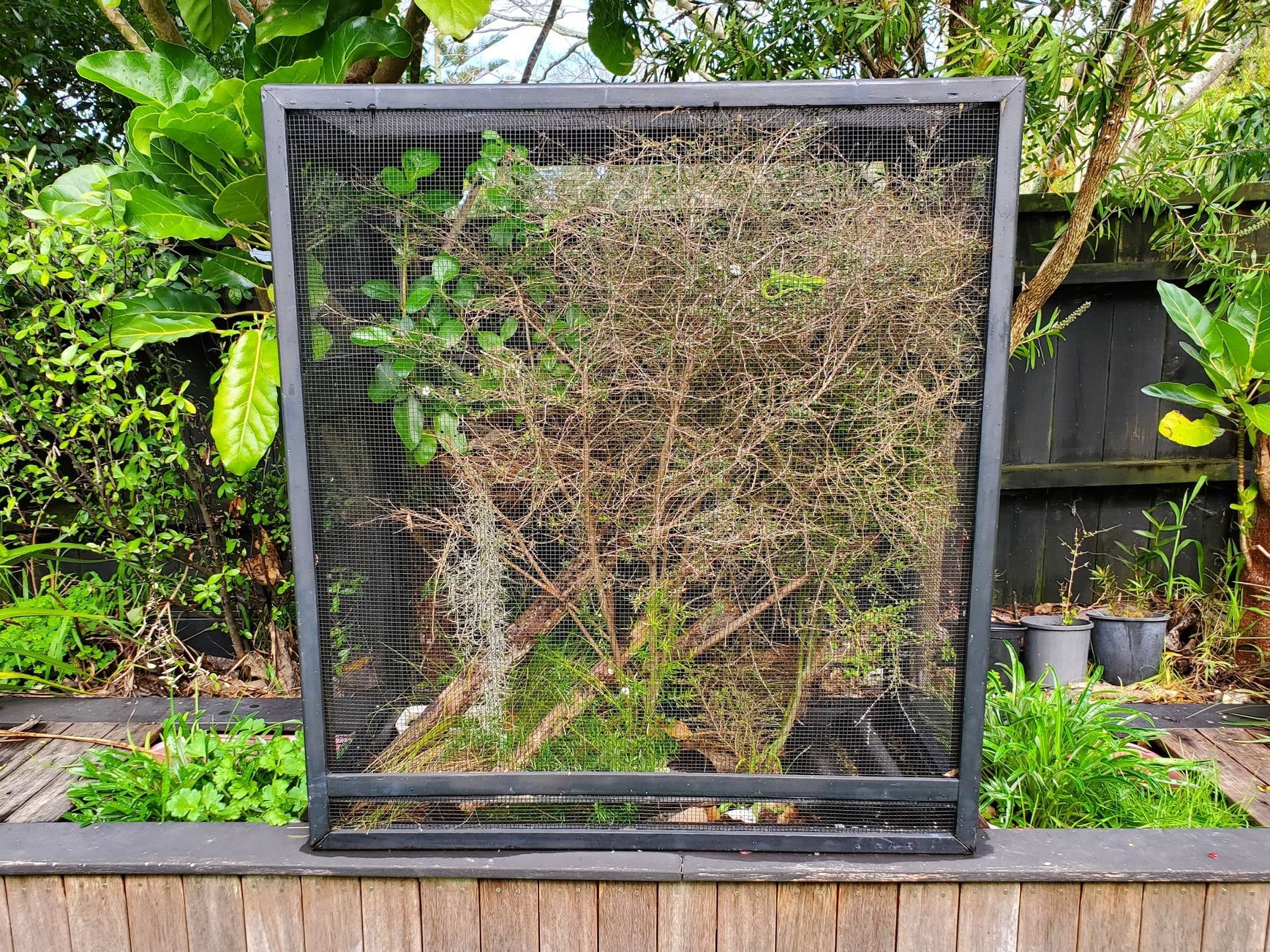
For more detailed information on housing / husbandry for NZ lizards refer to our Care Guides for NZ lizards and the DOC guide to keeping NZ lizards in captivity.


